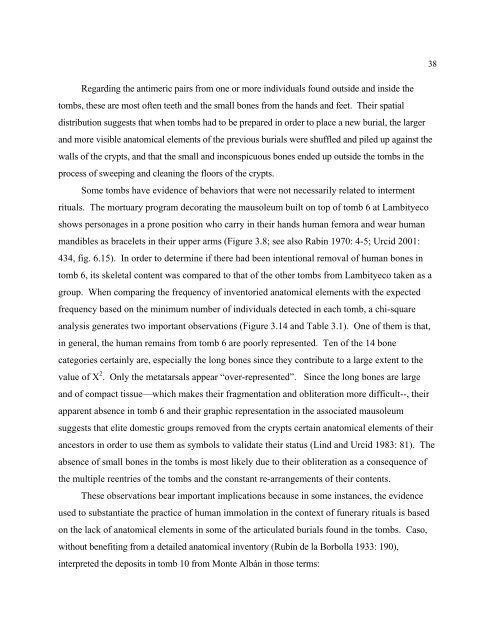Create successful ePaper yourself
Turn your PDF publications into a flip-book with our unique Google optimized e-Paper software.
Regarding the antimeric pairs from one or more individuals found outside and inside the<br />
tombs, these are most often teeth and the small bones from the hands and feet. Their spatial<br />
distribution suggests that when tombs had to be prepared in order to place a new burial, the larger<br />
and more visible anatomical elements of the previous burials were shuffled and piled up against the<br />
walls of the crypts, and that the small and inconspicuous bones ended up outside the tombs in the<br />
process of sweeping and cleaning the floors of the crypts.<br />
Some tombs have evidence of behaviors that were not necessarily related to interment<br />
rituals. The mortuary program decorating the mausoleum built on top of tomb 6 at Lambityeco<br />
shows personages in a prone position who carry in their hands human femora and wear human<br />
mandibles as bracelets in their upper arms (Figure 3.8; see also Rabin 1970: 4-5; Urcid 2001:<br />
434, fig. 6.15). In order to determine if there had been intentional removal of human bones in<br />
tomb 6, its skeletal content was compared to that of the other tombs from Lambityeco taken as a<br />
group. When comparing the frequency of inventoried anatomical elements with the expected<br />
frequency based on the minimum number of individuals detected in each tomb, a chi-square<br />
analysis generates two important observations (Figure 3.14 and Table 3.1). One of them is that,<br />
in general, the human remains from tomb 6 are poorly represented. Ten of the 14 bone<br />
categories certainly are, especially the long bones since they contribute to a large extent to the<br />
value of X 2 . Only the metatarsals appear “over-represented”. Since the long bones are large<br />
and of compact tissue—which makes their fragmentation and obliteration more difficult--, their<br />
apparent absence in tomb 6 and their graphic representation in the associated mausoleum<br />
suggests that elite domestic groups removed from the crypts certain anatomical elements of their<br />
ancestors in order to use them as symbols to validate their status (Lind and Urcid 1983: 81). The<br />
absence of small bones in the tombs is most likely due to their obliteration as a consequence of<br />
the multiple reentries of the tombs and the constant re-arrangements of their contents.<br />
These observations bear important implications because in some instances, the evidence<br />
used to substantiate the practice of human immolation in the context of funerary rituals is based<br />
on the lack of anatomical elements in some of the articulated burials found in the tombs. Caso,<br />
without benefiting from a detailed anatomical inventory (Rubín de la Borbolla 1933: 190),<br />
interpreted the deposits in tomb 10 from Monte Albán in those terms:<br />
38

















